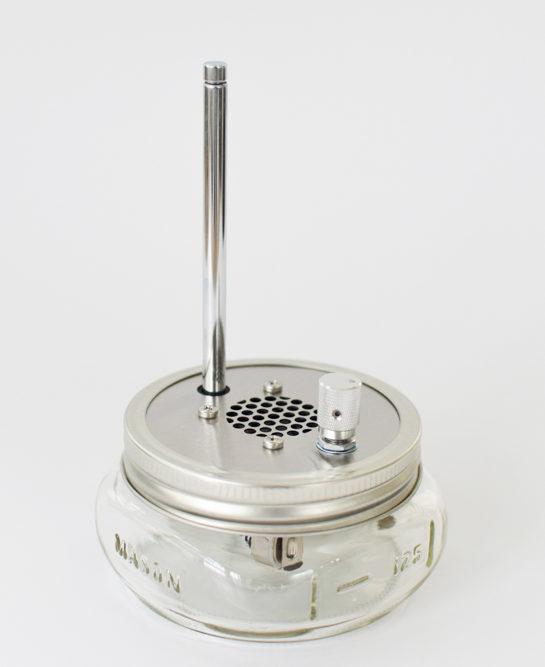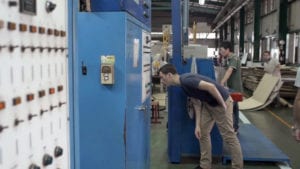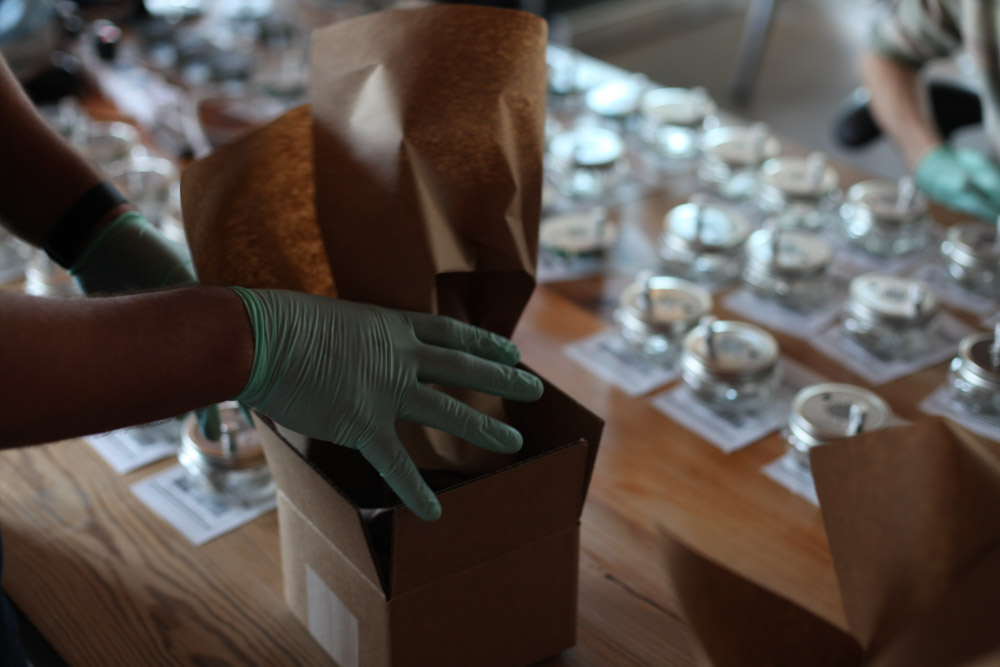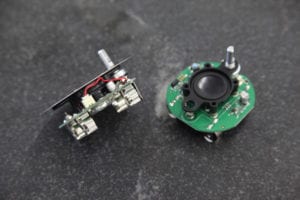A Simple Radio, a Complex Domestic Manufacturing Strategy
This single-channel FM radio is a rare example of US-made consumer electronics. Could other companies pull off this feat of manufacturing?
The product made its debut on Kickstarter, as so many electronics startups do these days. But unlike most projects that appear on the crowdsourcing site, the Public Radio isn’t an attempt to get a groundbreaking technology off the ground. In fact, it’s just the opposite. In an era of media devices that deliver limitless choices, this tiny radio is tuned to just one FM station, of the buyer’s choice. It cannot connect to the Internet of Things, although the unit is connected to a glass Ball Mason jar. It’s a charming device, and in the five years since engineer Spencer Wright and sound technologist Zach Dunham designed the Public Radio, they’ve sold more than 10,000 of them.
But monster sales figures aren’t the whole point of this project. “We initially did this because we thought it was something that we could do, and because it allowed us to test out some theories about electronics and supply chain design and see whether it would be possible to run a side business,” said Wright, who also works as a manufacturing expert in the metal 3D printing industry and runs the Prepared, a newsletter about hardware manufacturing.
The experience became an odyssey into the electronics supply chain and the realities of manufacturing outside of the Pearl River Delta. Concerns about labor, IP theft, and quality have made domestic manufacturing a hot topic conversation among US and European electronics suppliers and consumer electronics makers. Companies like Apple, which recently announced plans to open a new iPhone plant in India, have made it clear that cheap labor is the key to the high profits they enjoy. For the Public Radio, however, US manufacturing is a must: Each unit must be custom-tuned to a specific FM station per the request of the individual or institution that orders it. (For browsing music, Wright says, most people look to the internet. But for radio listening, they tend to stick with just one, much-loved channel.)
But first, let’s talk about the components inside this radio. The radio is priced at $59.99, and about $18.54 of that is the base cost of goods sold, which breaks down to 50% in US assembly labor costs and 50% for the bill of materials. The speaker and the FM receiver module (the same one, incidentally, that was used in the original iPod Nano) account for more than 21% of the materials total. Those and most of the microprocessors, passives, and electromechanical components used are either only made in China or cost-prohibitive to purchase from the US, especially at these low volumes.
“The speaker we used is from Shenzhen and costs $2.40 apiece. If we bought one made in the US, that part alone would probably cost $50,” says Wright. “If we used a 100% domestic supply chain, the radio would cost something like $200. That’s just not realistic. Consumers would not accept that.”
But there are risks involved with moving outside of the US supply chain, and in this product, connector compatibility became an issue.

The first 2,500 units, or version one of the radio, were assembled by the inventors’ friends and family in a series of pizza parties. The speaker had a little JST surface-mount connector. “Our speaker supplier soldered the wire assemblies — with the plug connectors — onto the speakers and shipped them to us. We glued the speakers to the PCBAs and plugged the wires into the surface mount receptacles,” said Wright.
During the design phase, they had to resolve a connector issue. “The samples were sent to us as just a little piece of 2-conductor wire with the connector attached, and the connectors appear to work just fine. Then we sourced another round of samples, this time representing the full speaker assembly, with wires soldered to speakers, and connectors crimped on. The connectors did not fit into the sockets we get from DigiKey.”
The team worked with their supplier to find a solution for the connectors, and the next batch of speaker samples worked well. There may have been minute changes in the overall system but it’s also possible gray market parts entered the supply chain. The experience is a cautionary tale about integration testing. “Issues of intellectual property are complicated in the Shenzhen ecosystem and supply chains are incredibly complex,” said Wright. “In the US, we like to think that ‘genuine’ things can be ‘guaranteed’ to work together, but in reality it’s on me as a product engineer to rigorously test every mechanical connection in my product. This holds whether I’m buying from China, Germany, or from across the street.”
After the initial Kickstarter, the business took a nearly two-year hiatus before relaunching. The second version of the Public Radio is put together at a US printed circuit board assembly house. “They populate the surface mount components, thru-hole solder the speaker, screw on the lid and the knob, and then when an order comes in, they program firmware, do a full functional test, and give the radio to the mailman,” said Wright.
He is satisfied with the order management and domestic manufacturing processes in place now. “The business infrastructure we have built in order to provide just-in-time shipping is quite sophisticated. We have a very tight e-commerce and drop-ship system in place; you would think we were a much larger electronics company,” he says. As for individual components, it’s always possible the future may bring more changes.

Spencer Wright, inspecting a cardboard manufacturing line in Taiwan.
Last year, tariffs raised the costs of several parts inside the Public Radio, a cost increase the business decided it had no choice but to absorb, rather than pass on. “It’s a meaningful amount and makes us less profitable. It makes business planning frustrating, because we don’t know what our costs will be. Some suppliers just give the printed circuit board assembly house a separate bill for tariffs. That makes our pricing less transparent, which makes it hard to make business decisions.”
Still, it remains cheaper to buy parts from China, Wright said, as the speaker example dramatically demonstrates. Wright doesn’t see a feasible way to manufacture most components in the US at prices that would make sense for the companies that need them. Assembling the Public Radio in the US is enough of an achievement, however.
“We created a well-made, well-thought-out product and got to push our engineering skills, and learn a lot about the larger electronics ecosystem. Plus, people really like it and we get a lot of positive comments, which is gratifying,” said Wright. “If you work at Apple, you don’t necessarily get that direct feedback. Despite the challenges, it’s been a delightful experience.”
Like this article? Check out our other 2019, Manufacturing, New Technology and telecom articles.
- Where in the World is Amphenol LTW’s Luc Kan? - April 23, 2024
- TE Connectivity’s Sustainability Efforts Pay Off - April 23, 2024
- What is a VGA Connector? - April 23, 2024







